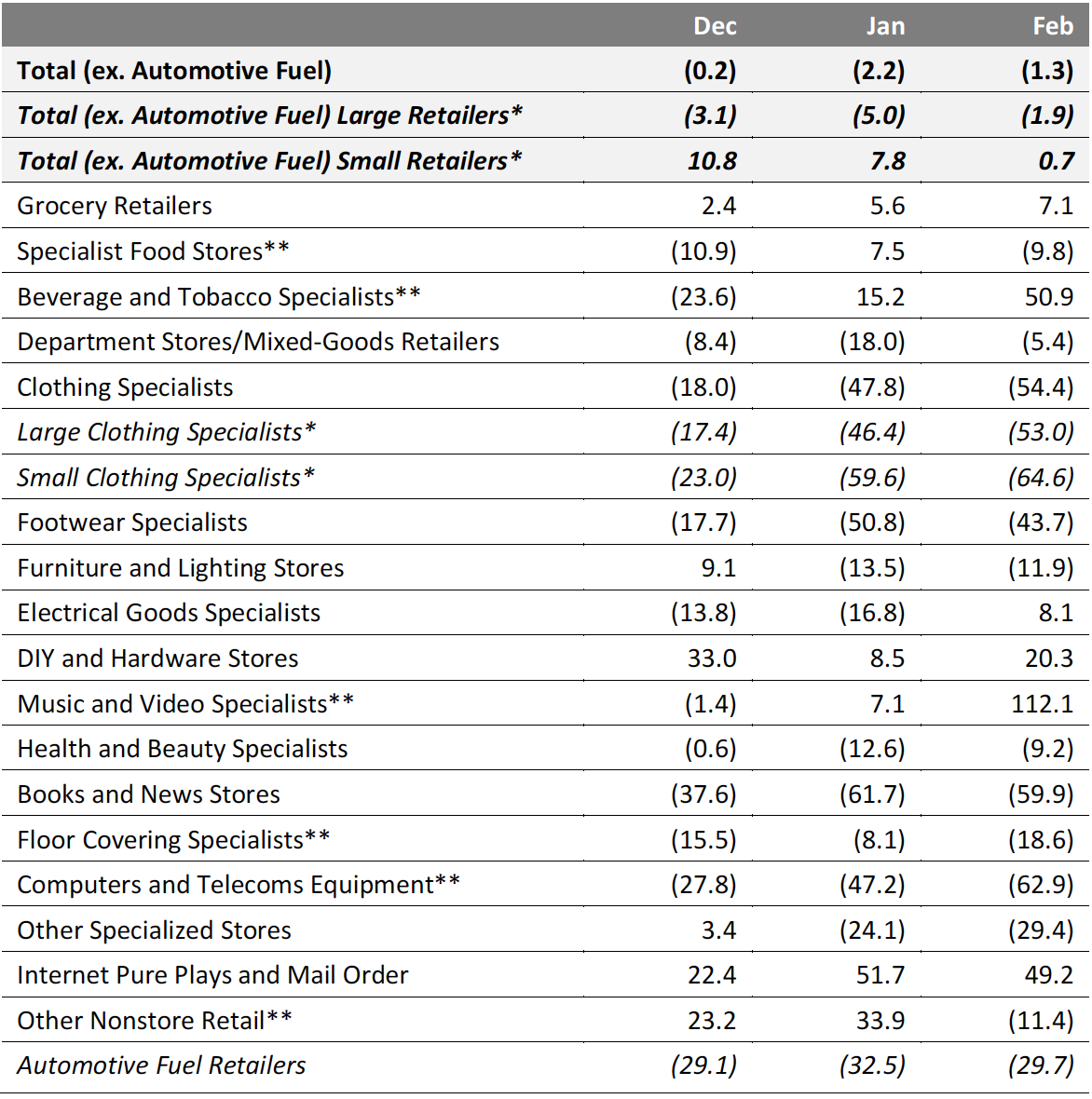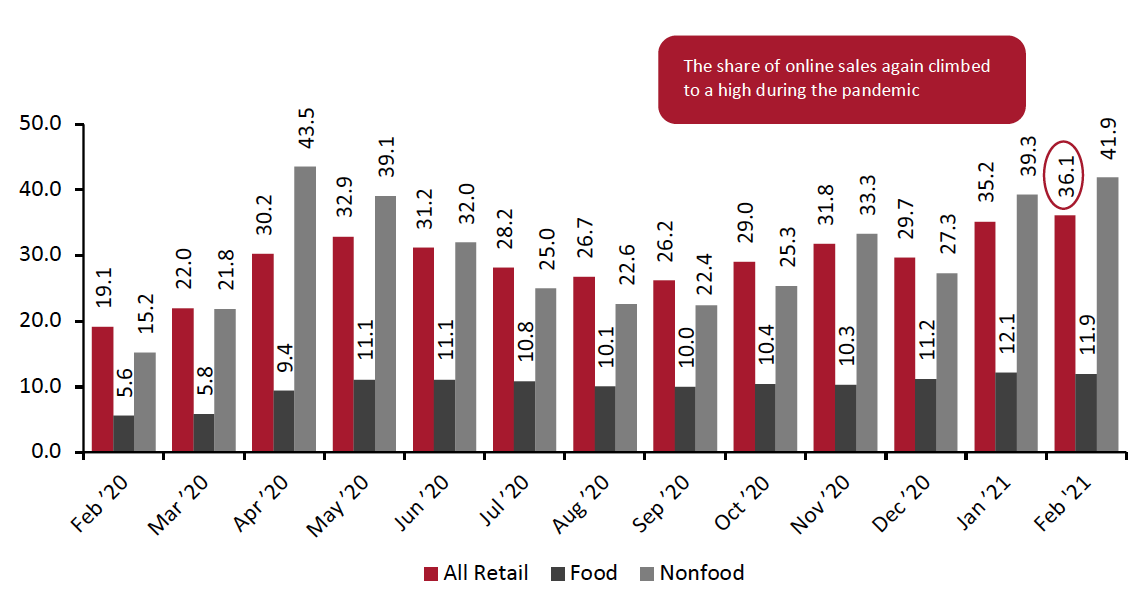
albert Chan
Figure 1. Total UK Retail Sales (ex. Automotive Fuel and Unadjusted): YoY % Change
[caption id="attachment_125052" align="aligncenter" width="700"] Data in this report are not seasonally adjusted
Data in this report are not seasonally adjustedSource: ONS/Coresight Research[/caption]
Retail Sales Growth by Sector
The overall retail sales decline in February is largely attributable to double-digit sales declines in several major sectors, most of which have suffered consistently throughout the pandemic and been hit especially hard during strict lockdowns.
Clothing and footwear specialists continued to see sales struggle in February: Clothing specialist retailers’ sales fell 54.4% year over year, compared to the prior month’s 47.8% drop, while footwear specialist retailers’ sales declined by 43.7%, following a 50.8% decrease in January. These sectors likely felt the most significant impact of the UK lockdowns: Year-over-year sales declines in each of these sectors more than doubled between December and January, when the latest lockdown was initiated.
Department stores—a sector also challenged by the pandemic—saw sales decline again in February, but at a much slower rate than in January. Department store sales declined by 5.4% year over year in February, a substantially improved performance compared to January’s 18.0% decline in sales.
Books and news stores, along with computer and telecoms equipment retailers, have also been consistently impacted by the pandemic and ensuing lockdowns. Sales in these sectors declined by 59.9% and 62.9% year over year, respectively. While consumers have spent fairly strongly on computers and other electronics as they work and play at home during the pandemic, the ongoing struggles among retailers in this sector indicate that consumers have switched some of their spending on these items to Internet pure-play retailers.
Despite overall sales declining, several sectors saw strong growth in February. Unsurprisingly, Internet pure plays continued to see strong sales growth, with sales rising by 49.2% year over year—roughly level with January’s 51.7% growth.
In keeping with another major lockdown-driven trend, DIY and hardware stores saw 20.3% growth in February, following relatively disappointing growth of 8.5% in January. Since June 2020, this sector has seen double-digit sales growth every month except January as home-bound consumers have turned their attention to projects around the house.
Electrical goods specialists saw sales rise 8.1% in February, following double-digit sales declines in December and January. February’s increase in sales may be an indicator that consumers are growing more optimistic about the economic impact of the pandemic and, therefore, are more comfortable in making large purchases.
Figure 2. UK Retail Sales, by Sector: YoY % Change
[caption id="attachment_125053" align="aligncenter" width="700"] *A small retailer is defined as one with fewer than 100 employees or with revenues of £60 million or less per year; all others are large retailers.
*A small retailer is defined as one with fewer than 100 employees or with revenues of £60 million or less per year; all others are large retailers.**A relatively fragmented sector, in which reported figures have traditionally been volatile.
Source: ONS[/caption]
Online Retail Sales Account for 36% of All Retail Sales
Online sales again benefited from lockdowns and the closure of nonessential stores in February, with sales rising by 77.6% year over year, up slightly from January’s 72.9% increase. Internet sales by food retailers saw particularly strong growth in February, increasing by 141.3% year over year—the fourth straight month that online sales in this category have risen by more than 100% year over year.
Nonfood retailers also saw strong growth in online sales, climbing by 98.5% in February, up from growth of 90.2% in January. Household goods retailers saw the largest growth in online sales among nonfood retailers, rising by 180.4% year over year. Apparel retailers’ online sales struggled slightly, with an increase of 36.3%, which is strong, but by far the weakest year-over-year growth among all categories.
Online sales grew slightly as a percentage of overall retail sales in February, reaching 36.1%. That equates to an increase of around 17 percentage points compared to online sales penetration in February 2020, and is roughly level with the 35.2% proportion recorded in January.
As with total retail sales, in March, online sales will begin annualizing the impact of March 2020 lockdowns, which fueled strong growth in e-commerce.
Figure 3. Online Retail Sales as % of Total Retail Sales
[caption id="attachment_125054" align="aligncenter" width="700"] “Food” and “Nonfood” data are for store-based sectors; “All Retail” total includes nonstore retail, which is not charted
“Food” and “Nonfood” data are for store-based sectors; “All Retail” total includes nonstore retail, which is not chartedSource: ONS[/caption]
Covid-19 Lockdown Timeline
Lockdown 1: The UK was put into lockdown on March 23, 2020, initially for three weeks, in an attempt to limit the spread of the coronavirus. Nonessential retail stores were closed.
On April 16, the government extended the lockdown by another three weeks.
On May 11, Prime Minister Boris Johnson announced that the government would begin easing restrictions in a phased manner, allowing nonessential stores to reopen from the start of June. However, garden centers were allowed to reopen from May 13 and furniture stores from May 23.
On May 26, the government announced that all nonessential retailers in England and Northern Ireland—including department stores and small independent shops—would be allowed to reopen from June 15, but stores would need to implement measures to meet the necessary social distancing and hygiene standards.
On June 23, Johnson announced that restaurants, pubs, museums, cinemas and hotels could reopen on July 4.
On September 14, a new “rule of six” prohibited social gatherings of more than six people, unless they are from the same household.
On September 22, Johnson outlined a slew of new restrictions in the wake of a fresh spike in the number of infections. These included the closing of bars, pubs and other hospitality services by 10:00 p.m., effective September 24.
On October 7, the Scottish government implemented tighter restrictions, largely on the hospitality industry. Retail was not directly affected, although stores were requested to enforce two-meter distancing.
On October 12, the UK government announced a three-tier lockdown system, which classifies regions based on the severity of infection rates. In the week beginning October 19, a number of regions in England, including London and Manchester, moved into higher “tiers” of control, which include restrictions on households mixing and, in some cases, some service industries; however, these did not change the direct rules for retailers.
On October 23, a 17-day lockdown began in Wales, with nonessential retailers being forced to close once more.
Lockdown 2: On October 31, Prime Minister Johnson announced a second lockdown for England for the period November 5 to December 2. All nonessential retail was forced to close, “including, but not limited to, clothing and electronics stores, vehicle showrooms, travel agents, betting shops, auction houses, tailors, car washes and tobacco and vape shops.” Food shops, supermarkets, garden centers and certain other retailers providing essential goods and services could remain open. Nonessential retail could remain open for delivery to customers and click-and-collect. Hospitality venues such as restaurants, bars and pubs were forced to close but could still provide takeaway and delivery services. Also forced to close were entertainment venues, indoor and outdoor leisure facilities, and personal care services.
Following the lockdown, UK regions were placed into different tiers, each of which had different restrictions.
On December 8, the UK’s National Health Service started vaccinations, with the aim of vaccinating the most vulnerable groups of people by February 15, 2021.
On December 21, the UK government scrapped a planned easing of rules on the mixing of households over the Christmas period. In England and Scotland, households in many areas were banned from mixing; in some areas, households could mix on Christmas Day only. The devolved Welsh and Northern Irish administrations implemented their own restrictions.
Lockdown 3: On January 4, 2021, Johnson announced a lockdown in England, effective January 5 and with an unspecified end date but with laws formally expiring on March 31. Scotland, Wales and Northern Ireland also implemented lockdowns.
On January 19, Scotland’s First Minister Nicola Sturgeon announced that that country’s lockdown would be extended until at least the middle of February.
On January 27, the government announced that travelers arriving from “red list” countries must quarantine in hotels specified by the government.
On February 22, the government laid out a roadmap to ending lockdowns in England. Restrictions will start to be eased from March 29, nonessential retail stores and services such as hairdressers will be allowed to reopen from April 12, and final restrictions will be ended on June 21.
On March 25, the UK lowered the Covid-19 risk level from four to three on a scale of five.